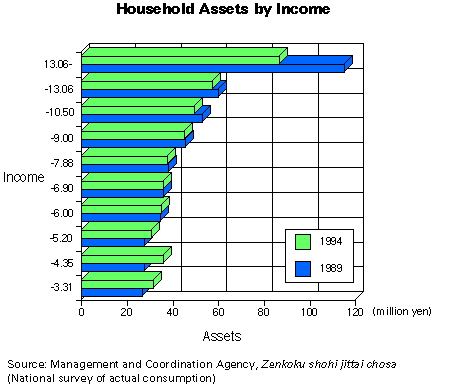
SMALLER GAP IN HOUSEHOLD ASSETS:
The Rich Get Poorer, the Poor Get Richer in the Post-Bubble Era
JULY 23, 1996
The agency based its findings on a survey of about 60,000 households comparing net assets, including land, buildings, and financial wealth, carried out before the collapse of the bubble, in November 1989, and five years later, in November 1994.
Household Assets Drop 4% on Average
Between 1989 and 1994, average assets per household declined 4.1% to 44.3 million yen (403,000 dollars at 110 yen to the dollar). Financial assets, calculated as savings minus liabilities, rose 25% to 8.5 million yen (77,000 dollars), as people put their money into savings in the wake of the downturn in stock prices. However, residential land, which accounts for more than 60% of assets, slid 15%, causing assets on the whole to fall.
According to a recent report, residential land prices plunged 34% over the previous year in the Tokyo metropolitan area, 29% in the Osaka metropolitan area, and 0.2% in and around Nagoya.
Soaring Assets of Lower-Income Earners
A breakdown of the change in assets among 10 income groups shows that households in the top bracket, with annual earnings of 13.06 million yen (118,000 dollars) or more, saw their assets plummet 24.8% to 86.4 million yen (785,000 dollars).
Households in the second highest bracket, with incomes from 10.5 million yen to 13.06 million yen (95,000 dollars to 118,000 dollars), and the third highest bracket, with incomes from 9.0 million yen to 10.5 million yen (82,000 dollars to 95,000 dollars), suffered respective declines of 4.9% and 7.1%. The single biggest factor behind the decrease was the drop in residential land prices. Families in the highest income group were not only hit by lower land values but the dwindling price of stocks and other financial assets and golf club memberships.
In contrast, households in the lowest income group, with annual earnings of less than 3.31 million yen (30,000 dollars), boosted their assets 18% to 31.3 million yen (285,000 dollars), and those in the bracket above this (3.31 million yen to 4.35 million yen, or 30,000 dollars to 40,000 dollars) upped their assets by 31.4%.
The assets of families in the third lowest bracket (4.35 million yen to 5.2 million yen, or 40,000 dollars to 47,000 dollars) rose by 11.1%, but no change occurred among upper-middle income households making 5.2 million yen to 9.0 million yen (47,000 dollars to 82,000 dollars).
Disparity Declines from Factor of 4.3 to 2.8
The collapse of the bubble economy had a major impact on the disparity of assets, stemming the bubble-era trend toward an even larger differential and bringing the gap back from a factor of 4.3 to 2.8.
Japan is said to be one of the few countries where the income gap between the haves and the have-nots is relatively small. The trend toward equalizing earnings gathered momentum after World War II and had as its underpinnings the following developments. The first was the breakup of financial cliques called "zaibatsu" right after the war, which led to the demise of a small class of extremely wealthy families.
The second was the reform of agriculture, which enabled tenant farmers to buy land cheaply and as a result boost their earnings. The third was the spread of various social welfare policies. The fourth was the guarantee of a minimum wage, pushed for by the newly formed labor unions, and the improvement of overall wages brought about by the achievement of full employment during the high growth era beginning in the mid 1960s.
Another important factor is the large number of big companies that are not owned by individuals but run by wage-earning managers, since in such places the pay differential tends to be relatively small. Such a wage structure has come to permeate the world of industry as a whole, and this in turn has become another force working to minimize the gap between the wages of the people at the top and bottom.
